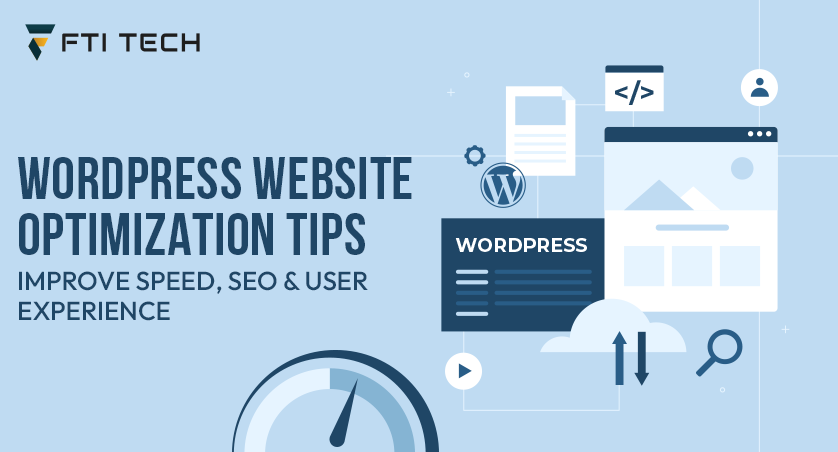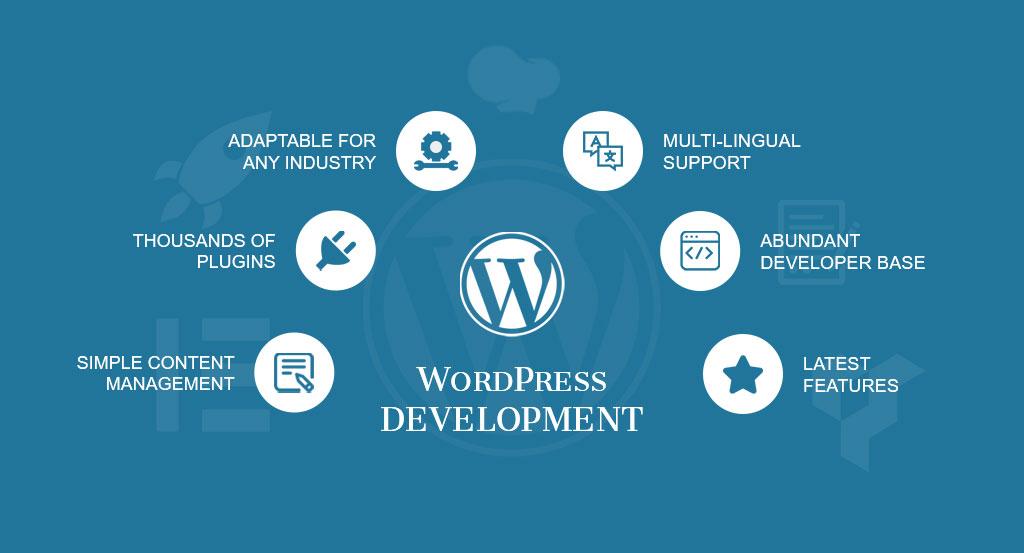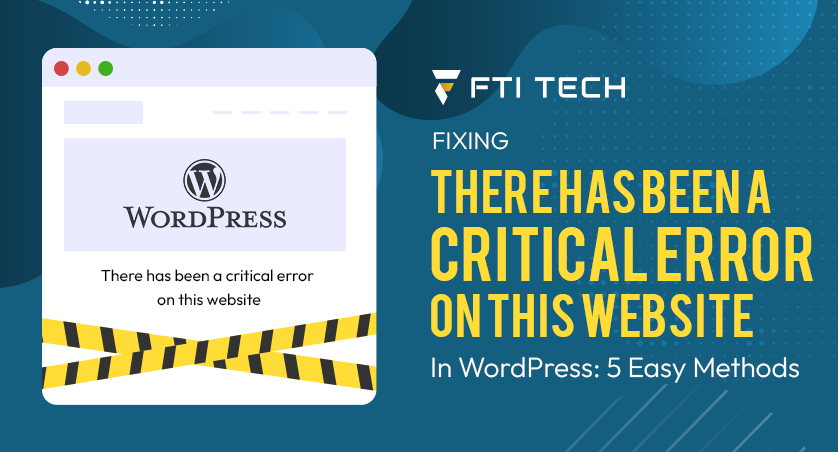How to Speed Up Your WordPress Website: Performance Optimization Tips
If your WordPress site loads in less than 3 seconds, then you are winning. But if not, 53% of your customers can leave the site immediately, and 79% of them might never return. This clearly shows how speed of your WordPress websites is important to your business. Whether you are a retail company, an eCommerce company, or an enterprise, you need to make sure that your site always runs smoothly.
But what causes your website to be slower?
Understanding the reasons is crucial to ensure you find the root cause and optimize it for a faster-loading WordPress website. This guide helps you identify the need for WordPress website speed, what causes slower loading, and tips to optimize it. Let’s start with the why first.
Why Website Speed Matters?
The speed of a website directly affects conversions since it influences customer experience, bounce rates, and even Google rankings via Core Web Vitals. Users need websites that are easy to use and load faster.
Impact on User Experience & Engagement
Quick WordPress websites provide enhanced experiences, resulting in reduced bounce rate and increased engagement. Ideally, all sites are supposed to load within 2-3 seconds. Mobile devices account for 64 percent of the traffic, so consistency across devices is an essential factor. Any difference in performance can make or break the user experience.
SEO and Core Web Vitals
Google lists speed as a ranking factor, making Core Web Vitals critical. The three key measures are:
- Largest Contentful Paint (LCP) is a measure of loading performance. Your LCP must take place in 2.5 seconds when the page begins its initial load. This measure deals with the time of the appearance of the most important content to users.
- Interaction to Next Paint (INP) is the measure of responsiveness and interactivity. INP of pages should be 200 milliseconds or fewer. This is how long it takes the user before they make a first interaction with your page, and the browser to react to that interaction.
- Cumulative Layout Shift (CLS) is a metric of visual stability. The CLS score on pages should be 0.1 or lower. This ensures that elements do not jump out of place when loading the page, which can frustrate users and cause them to click accidentally.
Conversion & Revenue Impact
Speed eliminates the friction between product discovery and checkout. Even moderate increases can take advantage of large conversion gains, in particular for eCommerce and subscription based services. Increased speed translates to quicker cart additions, easier checkouts, and increased browsing, which increases average order value.
More to the point, users also identify fast sites with professionalism and reliability, which builds brand trust, something FTI Tech helps businesses strengthen through optimized WordPress solutions.
Also Read: 7 Reasons why should you choose WordPress
Common Causes of Slow WordPress Websites
Here are some of the key reasons why your WordPress website is slower.
Bloated themes and plugins: Themes and plugins containing a lot of code, with outdated functionality, create additional overhead and reduce performance.
Shared or low-quality hosting: Resource sharing with hundreds of sites results in slow response, particularly when there is a traffic burst.
Unoptimized images: Big, uncompressed image files will slow down the pages and may load poorly when not optimized for cell phones.
Excessive scripts and external requests: Additional tracking scripts, fonts and widgets generate additional requests, which slow the rendering.
Uncached content and database bloat: Without caching, pages are loaded from scratch; in the long run, database clutter adds extra delays.
WordPress Performance Optimization Tips
WordPress speed optimization requires consideration of multiple aspects, right from images to caching, hosting service to themes and plugins. Here are some of the tips you can use,
Optimize Images
The Problem: Uncompressed images can be the only thing that slows a WordPress site down, adding unnecessary weight and a longer time to get the site loaded. This is especially harmful to mobile users.
How to Fix It: Turn pictures into the modern format of WebP or AVIF, which will decrease the file size without quality loss. Lazy load images so that they do not render until users scroll, and this increases perceived performance.
Tools: ShortPixel and Smush to use as automatics, TinyPNG as a manual compressor, and a3 Lazy Load as an improved lazy loading tool.
Use Caching
The Problem: Without caching, your WordPress site will recreate each page each time a user is served, and as a result, your database will receive an enormous amount of queries, and your site will run sluggishly.
How To Fix: Enable browser caching such that pages are stored on the disk, and server-side caching such that it also stores static pages.
Tools: WP Rocket to simple mode, W3 Total Cache to advanced mode, and LiteSpeed cache
Choose a Fast Hosting Provider
The Problem: Even the most optimizations cannot be used to solve slow hosting. Old servers or shared servers can reduce your WordPress hosting performance and impact uptime.
How To Fix: Use a managed WordPress hosting company offering SSD storage, prominent PHP versions, server-side caching with embedded CDNs.
Tools: Kinsta, WP Engine, and SiteGround.
Use a Content Delivery Network
The Problem: Visitors who are distant from your server will have to wait longer to load your website because of latency. The greatest sufferers are international traffic.
How To Fix: Implementation of a CDN to host your static assets on edge servers around the world so that users can access content as close as possible to them. This will minimize latency and increase the speed of loads across regions.
Tools: Cloudflare (free and premium plans), BunnyCDN, and StackPath.
Minify and Combine CSS and JavaScript
The Problem: CSS and JavaScript files that are not optimized add needless weight and need several HTTP requests, sluggishly loading your WordPress site.
How To Fix: : Compress files to eliminate whitespace and comments, and use the concatenation option to reduce the size of requests. Load scripts that are not required now asynchronously or in the future.
Tools: Autoptimize and WP Rocket to be easy to set up.
Clean Up Database and Revisions
The Problem: WordPress databases are full of old revisions, spam messages, and other temporary data, which slows down queries and makes backups larger.
How To Fix:Clean up old data regularly and optimize database tables to ensure that the performance is high. Automation will avoid manual work.
Tools: WP-Optimize and Advanced Database Cleaner.
Limit Plugins and Lightweight Themes
The Problem: Excessive code is added by many of these plugins and heavy themes, which slows down queries and causes conflicts. It affects the performance of the WordPress websites.
How To Fix:Have audit plugins audited frequently and eliminate unnecessary ones. Make use of lightweight, well-coded themes that are fast and flexible.
Tools: GeneratePress and Astra themes, in addition to quarterly reviews of the plugins
Enable GZIP or Brotli Compression
The Problem: Uncompressed HTML, CSS, and JavaScript code use more bandwidth and prolong the time of loading the websites without any real need.
How To Fix:Have your server enable GZIP or Brotli compression to squeeze response sizes. Test with performance checkers.
Tools: This is automatically configured in most managed hosts. Alternatively, set up through .htaccess or through the use of plugins such as WP Rocket.
Keep PHP and WordPress Updated
The Problem: The old versions of PHP are a lot slower in processing and putting your WordPress site at risk of security vulnerabilities. Earlier versions of WordPress lack important optimization.
How To Fix: PHP Upgrade to PHP 8.1 or later and maintain WordPress core, themes, and plugins updated to take advantage of performance and security enhancements.
Tools: PHP updates use your hosting dashboard, and core and plugins use the built-in updater provided by WordPress.
Implement Lazy Loading for Videos and iFrames
The Problem: Videos and embedded iFrames will be loaded instantly, even without the user viewing them. This makes it heavier and reduces website loading time.
How To Fix: Add lazy loading videos and iFrames to them so that they can only be loaded when they can be seen on the page.
Tools: Native HTML loading=lazy attribute and plugins such as WP YouTube Lyte..
If you have more complex projects, professional WordPress development services can help you make sure that your site is not only optimized for speed but also scalable, secure, and tailored to your business needs.
Advanced WordPress Speed Tips
The following are among the most viable tips that you can apply in your process of optimizing the speed of your websites.
Edge Caching with CDN: If your site has international users, edge caching adds extra value to a CDN by storing dynamic content nearer to the users. This eliminates the need for database queries and provides improved website performance.
Server Level Optimization: There are optimized server settings, such as NGINX, OPcache, and HTTP/2, that can give measurable improvement in performance. It conserves memory and enhances the rate of handling requests. Another method for optimization is by partnering with someone who provides server-level optimization.
Code Optimization for Developers: In the case of developers dealing with advanced sites, it is vital to get rid of unused CSS and JavaScript. Use of critical CSS would provide quicker rendering of above-the-fold content and decrease the loading of websites.
Also Read: Fixing “There has been a critical error on this website” In WordPress: 5 Easy Methods
Business Benefits of WordPress Speed Optimization
Increasing the performance of a WordPress site provides technical and business benefits. Faster loadings offer lower bounce rate and ensure that a visitor is not sent away. Compliance with Core Web Vitals will boost SEO, which increases the organic presence.
There are also conversion rates that are positively affected. Optimized sites use fewer resources, minimizing hosting costs and reducing the effort required to manage traffic surges. More to the point, users also identify fast sites with professionalism and reliability, which builds brand trust.
Conclusion
WordPress performance optimization is not a one-time change but a continuous process. Image compression and caching, as well as hosting and maintenance of databases, are all components of performance. The WordPress speed tips which we discussed in the blog will help site owners change slow websites into a fast and reliable business ally.
The faster website means better search engine optimization, increased interaction, and conversion, and lower costs. The faster your site is, the greater your online advantage. Need expert help speeding up your WordPress website? Contact us today to discuss tailored optimization solutions.


